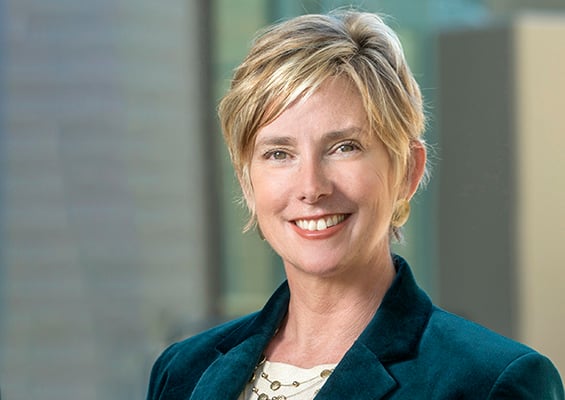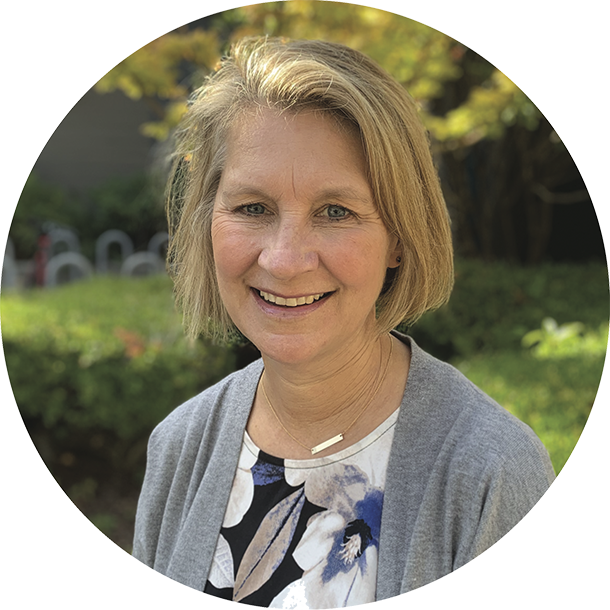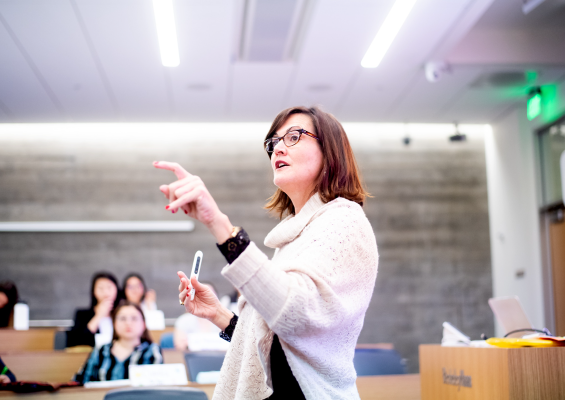From Global Fortune 500 organizations to the classroom, Brandi Pearce delves into how collaborative dynamics—simply put, teamwork—drive innovation, employee engagement, and belonging. Whether she is teaching the core Leading People class or the elective Leading High-Impact Teams or directing the co-curricular Teams@Haas program, she aims to inspire and empower students to lead teams that create value for their organizations in the future.
How would you describe your teaching style?
My guiding principle, learning with and through others, informs how I approach the classroom and all of my work in leadership and teamwork.
In practice, that means building an interactive classroom, one that pulls forward students’ curiosity and self-discovery. I love case studies as a way to bridge evidence and practice. Lab-based exercises allow students to use and think through a skill, followed by debriefing and talking about the theory and the science of what they have just done.
I encourage reflective practices. In the first session of the core Leading People class, for example, students work in threes to discuss and reflect on the kind of leader they want to be and where they hope to develop while at Haas. We capture that information in a survey, and, instead of reporting back about themselves, they share what they learned about their peers. On the last day of class, we return to the same questions to see whether and how their perceptions of how they want to lead people have shifted based on what they discovered during the course.
Haas is a sandbox for students to explore their own self-awareness."
What is Teams@Haas, and why is it important?
Students in all of our MBA programs are placed in academic teams—what the students historically called study groups. These groups are designed to give every student opportunities to connect with people from different backgrounds who have varied functional roles and who have lived in and experienced different places and cultures.
Teams@Haas supports those teams in learning to think systematically and intentionally about how to launch and cultivate a team over time. The program has specific objectives and goals. Teams@Haas encourages learning through practice. It is a sandbox for students to explore their own collaborative leadership qualities. Originally developed for the Full-Time MBA program, it now encompasses the Evening & Weekend MBA and MBA for Executives programs as well.
Teams@Haas is essential to achieving our intention to develop leaders who can work across a variety of environments and with a diversity of people.
How do your teaching, consulting, and research influence each other?
It’s exciting to be at Haas. Our students are interested in what’s next, what’s around the corner. They keep me on the forefront of how teams are evolving, where they are headed. That sparks my curiosity about ideas I want to research and explore.
For example, I developed a new module on leading sustainable organizations for this year’s Leading People class because students were so focused on sustainability. It was interesting to learn about that space, to identify gaps in the current knowledge base.
Earlier in my career, I spent time researching teams embedded in structures that did not have an overarching hierarchy, like alliance teams. When Covid-19 and remote work hit us, teams that once were embedded in a structured environment had to become more fluid and dynamic. How will that change as people return to offices? How do leaders think and talk about bringing people back?
Remote work changed teamwork, and not just because there is no embodied experience in Zoom meetings. Research, including that done by my colleague David Holtz, demonstrates that communication is more insular and siloed among teams working remotely. Another aspect of remote work is the ability to reach and hire a more diverse pool of applicants. This has significant implications for organizations and leaders orienting us to the importance of being more intentional in how people connect and share information, particularly when they are not physically co-located. Every shift in how organizations function brings new leadership opportunities and challenges.
How would you describe Berkeley Haas MBA students?
Three things come to mind. First is curiosity. They are looking for—and often creating—the next frontier. I appreciate that attribute and value it in a leader. Second is intentionality. Students come to Berkeley Haas because they care about building businesses that create not just market value, but value for people and society. Lastly, that our students are divergent thinkers. They really do Question the Status Quo. I am constantly amazed at the wide swath of their endeavors and ideas.
What do you hope students will take away from your classes?
If I had to choose one takeaway, it would be reflexivity because it reinforces so many outcomes of teamwork. By reflexivity, I mean the capacity of a team to step back and reflect on its own strategies, goals, and dynamics, and then to create strategies for the team’s continued development. It is a powerful process to motivate behavior, align action, and close gaps in understanding that ultimately power both self-and collective awareness.
More broadly, I hope students continue to think deeply about the nature of teamwork in the organizations they lead. To ask themselves: what are their teams trying to accomplish? In what context are they embedded? What are the social implications of both of those things?
The answers to those questions change how leaders approach their teams. A team designed for innovation, for example, needs to be comfortable with trial-and-error, failure, and iteration. A team focused on efficiency might want to prioritize structure, coordination, and communication to promote effectiveness.
Ultimately, when teams serve as a sandbox for both team and individual development, leaders are poised to not only reach their team performance targets but to simultaneously create space for personal growth and engagement—creating value for individuals, teams, and their organization.
The expertise and insight your professors bring helps deepen and enhance your MBA journey. By selecting a top school with top-notch professors, you maximize your experience.

Read more from the Take 5 with a professor series:
- Jon Metzler connects people and places in ways that foster innovation
- Homa Bahrami explores agility and flexibility for enterprises and individuals
- Cameron Anderson can prove that being a jerk is not a good career strategy
- Laura Kray reveals the skill MBAs want in their core curriculum
- Kellie McElhaney talks equity fluency, courage, and vulnerability
- Lucas Davis shares hardest economic concept for MBA students to grasp
- Jenny Chatman gives three benchmarks of an effective organizational culture
- Jennifer Cohen talks equitable and inclusive leadership
- Clark Kellogg shares how he teaches design thinking, creativity, and innovation
- Dave Rochlin talks flipping the classroom: MBAs learn by doing
- Maura O'Neill says narrow-mindedness is the enemy of innovation
- Bill Pearce says most important trait of a successful marketer is empathy








